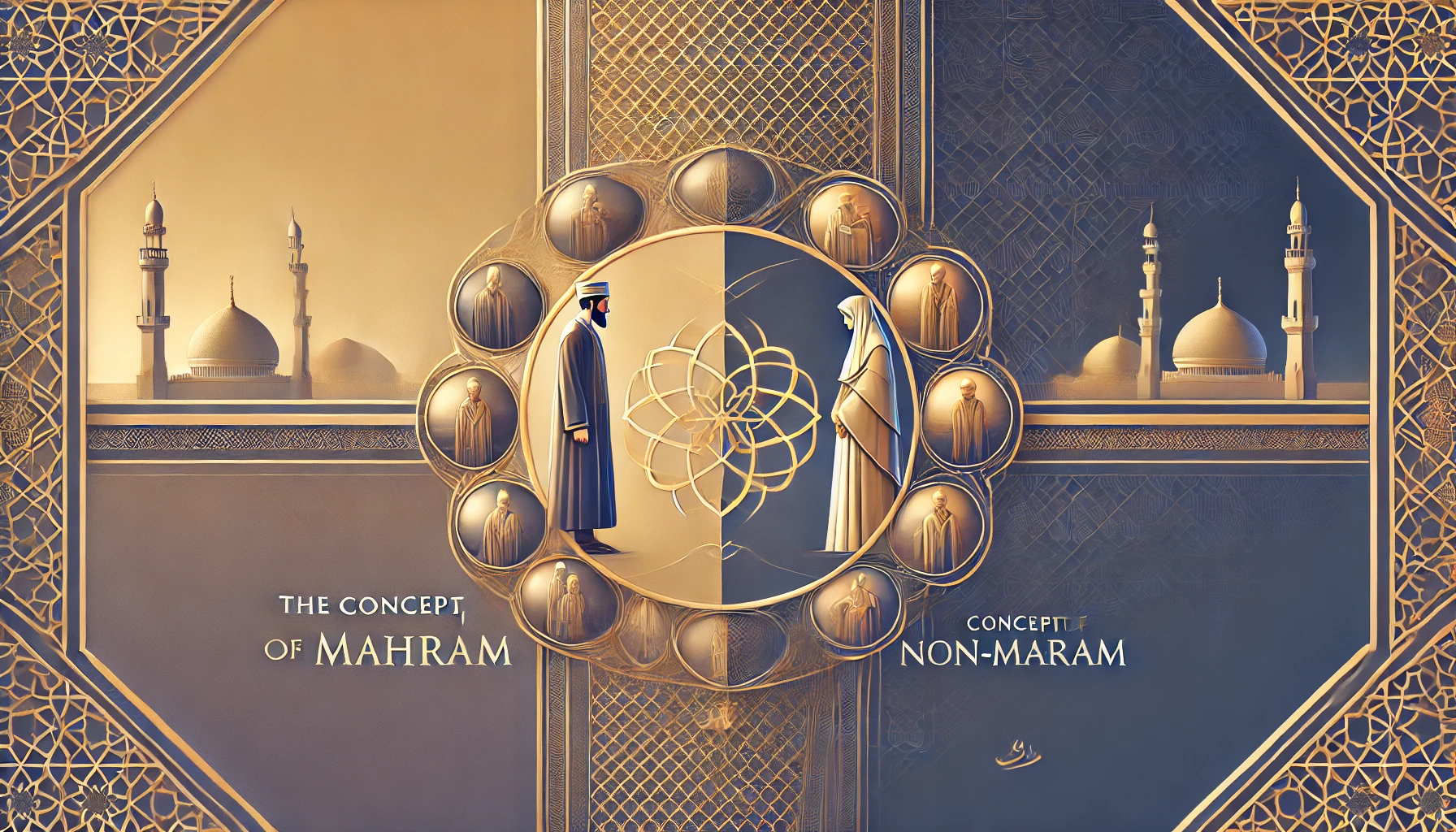The concept of Mahram and non-Mahram
The concept of Mahram and Non-Mahram are integral to Islamic social and legal norms, defining the limits of permissible interactions between individuals of opposite sexes. Mahram is a person with whom marriage is permanently forbidden due to consanguinity (blood relations), breastfeeding, or marriage relations. Mahram plays a significant role in Islamic personal law and social customs, particularly regarding hijab regulations, physical contact, and privacy.
The Almighty God has clearly instructed the believers about this concept in His holy book Qur’an Surah al-Noor, Verse 30 and 31. The prohibition of relationships between unrelated men and women can also be understood by two other verses from the Quran: Verse 5 of Surah Al-Ma'idah and Verse 25 of Surah An-Nisa.
Additionally, the story of the daughters of Prophet Shu'aib and their avoidance of mixing with non-Mahram men illustrates this principle in Surah Al-Qasas, verses 22-23.
There are plenty hadiths on the concept of Mahram and non-Mahram. For example:
The Prophet Muhammad (Peace be upon him & his progeny) said:
"It is better for one of you to be struck in the head with an iron nail than to touch a woman who is not permissible for him." (Bihar al-Anwar, Vol. 76, Pg. 35)
This hadith underscores the importance of avoiding physical contact with non-Mahram individuals to uphold Islamic ethics.
Imam Ali (peace be upon him) said:
"Do not shake hands with women, for this will inflame desire, and protect yourself from interactions with non-Mahram women to preserve your faith." (Nahjul Balagha, Saying 31)
This hadith highlights the importance of avoiding physical contact and inappropriate interactions with non-Mahram individuals.
Imam Zainul Abideen (peace be upon him) said:
"The right of your sight is that you lower it from what is unlawful for you. If you do so, it will purify your heart and guard your dignity." (Risalat al-Huquq, The Treatise on Rights)
This hadith links the control of one’s gaze with the protection of moral integrity and spiritual purity.
Categories of Mahram Relationships:
1. By Blood: Immediate family members such as parents, grandparents, siblings, children, and grandchildren.
2. Through Marriage: In-laws like one's spouse's parents, one's daughter's or son's spouse, and in the case of a woman, her husband's sons from previous relationships.
3. By Breastfeeding (Rada'a): Islamic law considers those breastfed by the same woman as siblings, making them Mahram to each other, under specific conditions detailed in Islamic jurisprudence.
Dress Code: Women do not need to observe the hijab in front of their Mahram men.
Non-Mahram is anyone to whom one is not related in any of the ways that would prohibit marriage under Islamic law. This includes most people one encounters in social settings, such as friends, colleagues, and distant relatives.
Interaction Guidelines with Non-Mahram:
1. Direct physical contact between opposite sexes who are non-Mahram individuals is generally prohibited in Islamic practices.
2. Being alone with a non-Mahram (Khalwa) is discouraged to prevent any situations that might lead to temptation or social censure.
3. Women are required to wear hijab in the presence of non-Mahram men, covering their hair and body except for the face and hands.
These classifications guide daily interactions and are meant to foster social modesty and respect between individuals in Islamic cultures.
Overall, the concepts of Mahram and Non-Mahram continue to influence many aspects of social life among Muslims, underscoring the importance of familial bonds and ethical interactions in Islamic tradition.
Mahrams by Blood for Women
The following relatives are considered Mahrams for a woman due to blood relations:
- Father and Grandfathers
- The woman’s father and paternal or maternal grandfathers, no matter how far up the lineage goes.
- Son and Grandsons
- The woman’s own son, as well as her grandsons through her sons or daughters, no matter how far down the lineage goes.
- Brother
- Any man who shares the same father, mother, or both with the woman.
- Nephews
- The sons, grandsons, and great-grandsons of the woman’s brothers.
- The sons, grandsons, and great-grandsons of the woman’s sisters.
- Uncles (Paternal and Maternal)
- The woman’s paternal uncles (father’s brothers).
- The woman’s maternal uncles (mother’s brothers).
- This also includes the uncles of her father, mother, grandfathers, and grandmothers.
Notes on Specific Uncles (Extended Relatives)
- A great-uncle or distant uncle (e.g., the uncle of the woman’s father’s uncle) is only considered Mahram if he is also the uncle of her direct parents (father or mother). Otherwise, he is not Mahram.
Mahrams for Women by Marriage (Sababi)
Mahrams by marriage are individuals who become Mahram to each other through a valid marriage contract, whether permanent or temporary (Nikah). This relationship of Mahram remains intact even in some situations, such as after divorce or the husband's death.
- Father-in-Law and Grandfathers of the Husband
A woman becomes Mahram to her husband’s father and paternal or maternal grandfathers, no matter how far up the lineage goes.
This Mahram relationship remains even if the husband passes away or the couple gets divorced.
- Step-Sons (Sons of the Husband from a Previous Marriage)
A woman becomes Mahram to her husband’s sons from a previous marriage.
Mahrams by Blood (Nisbi) for Men
Mahrams by blood for men are female relatives with whom marriage is permanently forbidden due to close kinship. Below is the list of such Mahrams:
1. Mother and Grandmothers
- The man’s mother.
- Maternal and paternal grandmothers, regardless of how far up the lineage goes.
2. Daughters and Granddaughters
- The man’s own daughter.
- Granddaughters through his sons or daughters, including great-granddaughters, no matter how far down the lineage goes.
3. Sisters: Any woman who shares the same father, mother, or both with the man.
4. Nieces: Daughters of the man’s sister, including her granddaughters and great-granddaughters.
- Daughters of the man’s brother, including his granddaughters and great-granddaughters.
5. Paternal Aunts (Ammah)
- The man’s paternal aunts (father’s sisters).
- Paternal aunts of his father and mother.
- Paternal aunts of his grandfathers and grandmothers, no matter how far back they go.
6. Maternal Aunts (Khala)
- The man’s maternal aunts (mother’s sisters).
- Maternal aunts of his father and mother.
- Maternal aunts of his grandfathers and grandmothers, no matter how far back they go.
Notes on Distant Aunts
- If a great-aunt (e.g., an aunt of the man’s parent’s aunt) is also the direct aunt of his parent, she is considered Mahram. Otherwise, she is not Mahram.
Mahrams by Marriage (Sababi) for Men
Mahrams by marriage are individuals who become permanently Mahram to a man due to a valid marriage contract with their relative. These relationships remain even after divorce or the death of the wife.
1. Mother-in-Law and Grandmothers of the Wife
- The mother of the wife and her maternal and paternal grandmothers, no matter how far up the lineage goes, become permanently Mahram to the husband (son-in-law).
- This Mahram status remains intact even after the death of the wife or divorce.
2. Step-Daughters (Daughters of the Wife from a Previous Marriage)
- The step-daughters (wife’s daughters from a previous marriage) becomes Mahram to the husband.
- This Mahram status is established only after the consummation of the marriage between the husband and the wife.
Mahrams by Breastfeeding (Rida'i)
When a woman breastfeeds a child under specific conditions outlined in Islamic law, the child becomes her foster child and is considered Mahram to her and certain relatives. Below is the detailed list of Mahrams by breastfeeding (Rida'i):
1. Mahram Relationships through the Breastfeeding Woman (Foster Mother)
- The breastfeeding woman herself becomes Mahram to the child.
- All children of the breastfeeding woman (born before or after the breastfeeding) become Mahram to the child.
- The father of the breastfeeding woman (maternal grandfather) becomes Mahram.
- The mother of the breastfeeding woman (maternal grandmother) becomes Mahram.
- The brothers of the breastfeeding woman (maternal uncles) become Mahram.
- The sisters of the breastfeeding woman (maternal aunts) become Mahram.
2. Mahram Relationships through the Husband of the Breastfeeding Woman
- The husband of the breastfeeding woman (foster father) becomes Mahram to the child.
- The father of the husband (paternal grandfather) becomes Mahram.
- The mother of the husband (paternal grandmother) becomes Mahram.
- The brothers of the husband (paternal uncles) become Mahram.
- The sisters of the husband (paternal aunts) become Mahram.
Key Rules about Foster Relationships
Conditions for Breastfeeding to Establish Mahram Status:
The child must be breastfed at least 15 times or for a continuous period such that the milk becomes the sole source of nourishment during that time.
The breastfeeding must occur before the child reaches the age of two.
Scope of Mahram Relationship:
The Mahram relationship only applies to the child being breastfed. It does not extend to the child’s biological relatives (e.g., biological siblings of the breastfed child are not Mahram to the breastfeeding family).
Legal Equivalence:
A foster mother is treated like a biological mother regarding Mahram status, and her husband is treated as the child’s father.
To know more about Pure Islam, Please visit the website: findtruth.co.uk











